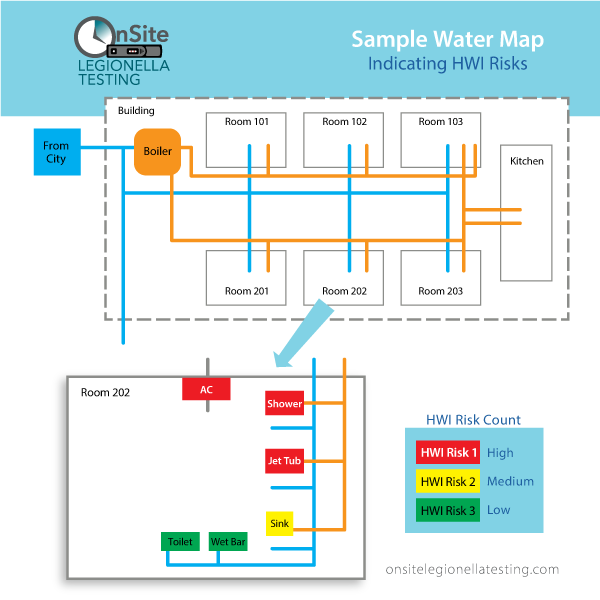2nd in a 10-part series
The controlling document for Risk Management in the Built Environment is ANSI/ASHRAE* 188-2015
A human water interface (HWI) is any place where humans contact water. Per ANSI/ASHRAE 188-2015 the owners/operators of systems have a duty to produce a Water Map showing existing, new, renovations, additions and or modifications to piping systems and human water interfaces specifically:
The Water Map should be completed if the building/facility has:
- Open and closed-circuit cooling towers and evaporative condensers
- Whirlpool or spas in the building or on the site
- Fountains, misters, atomizers, air washers, humidifiers
- Other water systems that release aerosols
The Water Map should also be completed if the system is in:
- Multiple housing units with centralized water heater systems
- Building more than 10 levels high including subterranean structures
- Health care facilities:
- Where a patient can stay > 24 hours
- Housing persons over 65 years of age
- That treats burns, cancer or does organ transplants
- That treat immunocompromised individuals, diabetics, those with renal disease
After the Water Map is completed, showing all HWI’s, a systematic analysis of hazardous conditions in the building water system’s HWIs is to be completed and locations where control measures are required are identified.
For each control measure at each control location the owner/operators must determine the limits, including a range of values within which a chemical or physical parameter must be monitored and maintained, in order to reduce hazardous conditions to an acceptable level.
A systematic program for monitoring the parameters associated with the control limits established is also required. The systematic program should include the following:
- Corrective actions for when monitoring indicates that the control parameters are outside of the established control limits.
- Procedures to confirm all Program elements are being implemented as designed.
- Documentation and recordkeeping concerning all procedures.
With the above requirements it is easy to understand all HWI’s do not present an equal risk when it comes to Legionella:
Human Water Interface Risk Categories
| High Risk | Medium Risk | Low Risk |
| Cooling tower Evaporative “swamp” cooler Hot tub Shower Fountains Sink Decorative Fountain | Toilet Urinal Drinking Fountain Ice Machine Irrigation system | Outdoor bodies of still water (ocean, lake, pond) Outdoor bodies of moving water (river, well) |
Legionella risk is based on 3 key factors managed by the Owner/Operator:
- How well is the HWI maintained with biocide to control biological population?
- How well does the system control biofilms and deposits?
- What is the system’s potential to generate aerosols that are likely to be inhaled?
Assessing your system for these three risk factors is critical for Owner/Operators to be in compliance with ANSI/ASHRAE standards. Failure to properly assess, manage, and document compliance with the standard leaves Owner/Operators at significant risk of legal claims and class actions from workers or customers who may contract Legionnaire’s Disease.
On Site Legionella Testing offers an established rigorous and affordable process grounded in scientific methods to assess, manage, and document your facility’s compliance with the legal standards necessary to protect against real or specious claims.
*ANSI/ASHRAE is American National Standards Institute/American Society of Heating, Refrigerating and Air-Conditioning Engineers: https://www.ashrae.org/technical-resources/bookstore/ansi-ashrae-standard-188-2018-legionellosis-risk-management-for-building-water-systems

